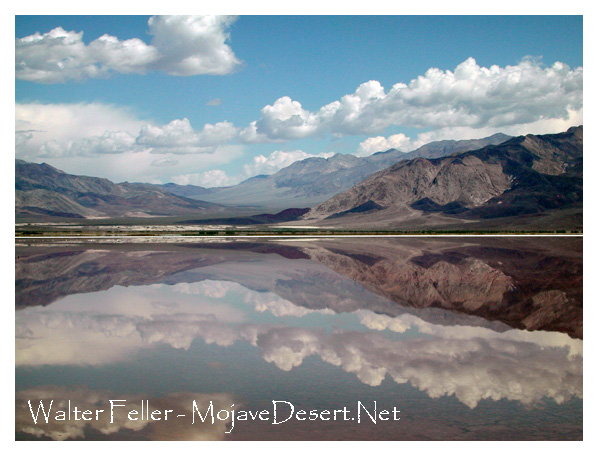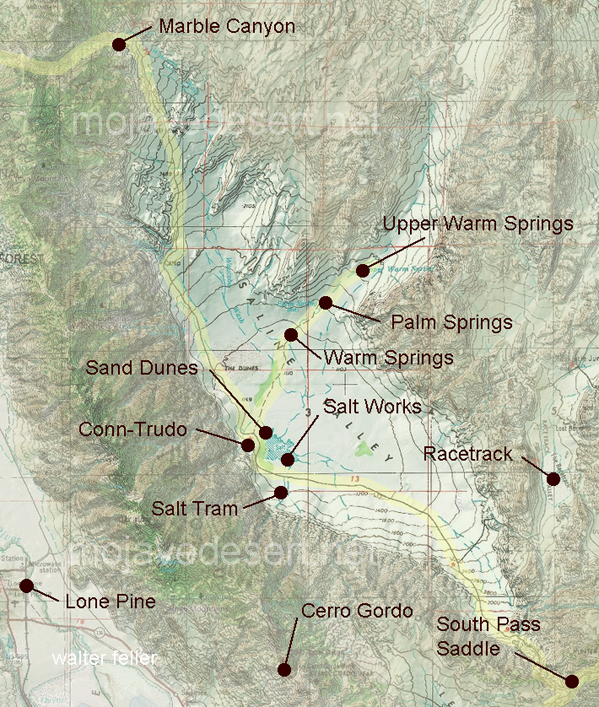--
Saline Valley

Saline Valley is located in the northwestern portion of Death Valley National Park, northwest of Death Valley and east-northeast of the Owens Valley.
Saline Valley is a remote and desolate area located within Death Valley National Park. It is known for its unique natural features and breathtaking landscapes. This document aims to provide an informative overview of Saline Valley while adhering to the instruction of refraining from conversational behavior.
Saline Valley is situated in the northern part of Death Valley National Park, encompassing an area of approximately 200 square miles. Its vast salt flats, rugged mountains, and hot springs characterize it. The valley is surrounded by the Inyo Mountains to the east and the Saline Range to the west, creating a striking backdrop against the barren landscape.
One of the notable features of Saline Valley is the Saline Valley Salt Tram, a historic tramway that was used in the early 1900s to transport salt from the valley to Owens Lake. Although the tram is no longer operational, remnants of the tramway can still be seen, serving as a reminder of the valley's rich history.
The valley is also home to several natural hot springs, which are a popular attraction for visitors seeking relaxation and rejuvenation. These hot springs offer a unique opportunity to soak in the warm waters while surrounded by the vastness of the desert. However, it is important to note that the hot springs in Saline Valley require a high-clearance vehicle and advanced planning due to the remote and rugged nature of the area.
In addition to its natural wonders, Saline Valley provides opportunities for outdoor activities such as hiking, camping, and photography. The valley is home to various desert flora and fauna, including Joshua trees, desert bighorn sheep, and various birds. Exploring the valley on foot allows visitors to appreciate this remote location's tranquility and its sense of solitude.
It is important to note that Saline Valley is a remote and harsh environment, and visitors must come prepared with appropriate supplies, including food, water, and navigation tools. The extreme temperatures and lack of amenities make planning and being self-sufficient while exploring this area crucial.
Saline Valley is a hidden gem within Death Valley National Park, offering a unique and off-the-beaten-path experience for those willing to venture into its remote reaches. Its rugged beauty, natural hot springs, and rich history make it a destination for nature enthusiasts and adventurers.
In conclusion, Saline Valley in Death Valley National Park is a captivating destination showcasing the desert landscape's raw beauty. Its salt flats, mountains, hot springs, and historic tramway provide a glimpse into the area's rich natural and cultural heritage. Whether you seek solitude, relaxation, or adventure, Saline Valley offers a unique experience that will leave a lasting impression.

Saline Valley Photos
Saline Valley Dunes
Low and sweeping, the Saline Valley sand dunes grace the salt lake near ...Conn Trudo Borax Works
Borate minerals were extracted here years before both the ...Warm Springs
Warm Springs and Palm Spring, in the Saline Valley, have been popular ...Saline Valley Salt Works
During World War I, nearly pure salt was extracted from the ...Saline Valley Salt Tram
Remarkably pure salt was extracted from the brine in the Saline Valley ...Grapevine Canyon Wildflowers
Spread across the alluvial fan ascending Grapevine Canyon at the southern end of ...Marble Canyon
In a narrow canyon along the northern entrance to the Saline Valley, is a ...Natural Features
Hot springs, a dry lake with a salt marsh and sand dunes are natural features of the valley.Saline Valley Geology
One needs to be in a particular mood to visit the Saline Valley. The access is long, often ...History
Saline Valley was inhabited in late prehistoric times by the Timbisha (also known as Panamint or Koso). The Timbisha Shoshone were relocated from the area in 1933 to nearby Darwin, California.The Conn and Trudo Borax Company mined borax in the valley from 1874 to 1895. Salt mining began in 1903 and continued into the 1930s. An aerial tramway was constructed in 1911 to carry salt 13.5 miles from an elevation of 1100 ft in the Saline Valley, to 8500 ft. over the Inyo Mountains, then down again to 3600 ft. in the Owens Valley.